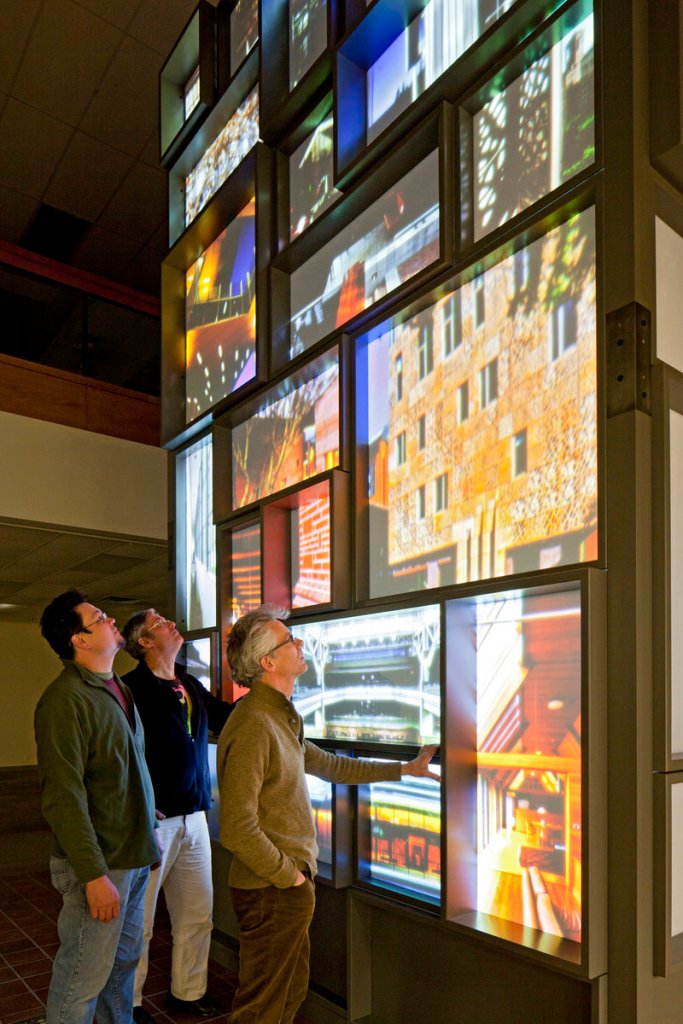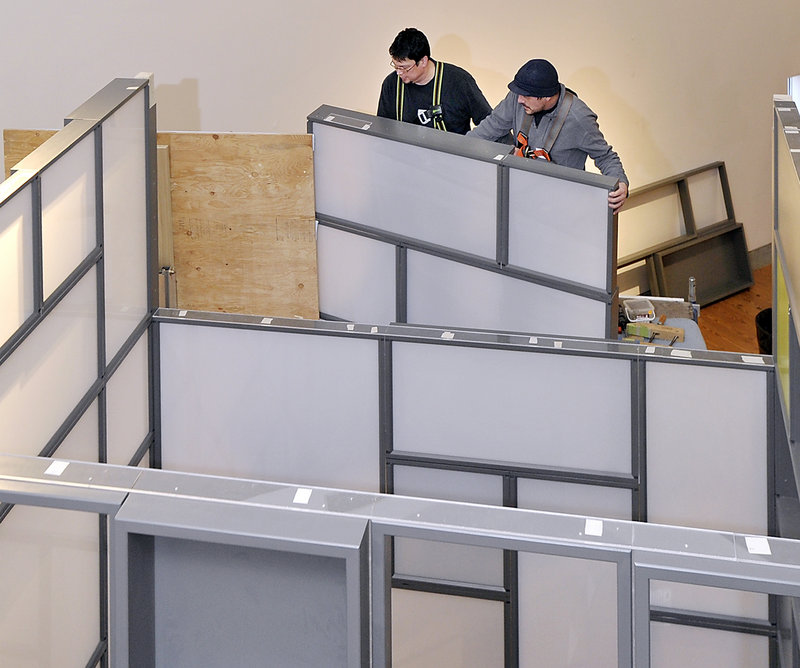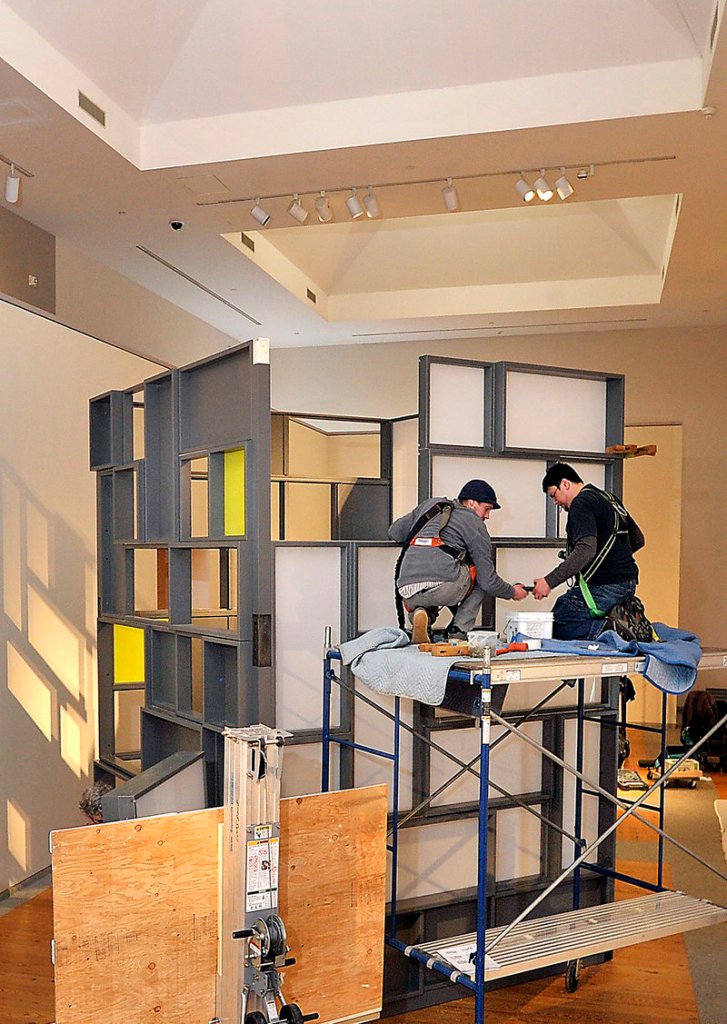Please, feel free to touch the tower.
On Saturday, the Portland Museum of Art opens an exhibition that celebrates 25 years of the Portland architecture and design lecture series, Architalx.
The centerpiece of the third-floor installation is a sculptural piece that stands 17 feet tall and mirrors, in its shape, the skylight at the top of the room.
The tower features three levels of images and projections that riff on a dozen or so themes that have been recurring subjects of lectures in the long-standing series. Those themes include nature, place, material, process and responsibility, and — perhaps most surprising — optimism.
It’s an interactive tower, with a touch pad and light sensors that trigger when people engage the structure with their touch.
Ann Casady, co-chair of the 25th-anniversary committee and a member of the Architalx board of directors, hopes visitors get hands-on with “the touch tower.” Most exhibition pieces in the museum are not to be touched, but this one is different.
“We want people to touch it. We want them to see what it’s all about, and explore,” she said.
The exhibition, formally titled “Voices of Design,” is on view through May 19. The annual lecture series, which features leading national and international voices in the architecture community, runs April 4-25, with four lectures on successive Thursdays.
Portland architect John Turk helped curate the exhibition with Robert Wolterstorff, former director of the Victoria Mansion in Portland. Turk views the tower more as aesthetic stimulation than a didactic exhibition — though the tower is full of information for those who choose to explore it.
“The museum gave us a directive that what we produced needed to be art. The tower fulfills that. It’s sort of a sculpture,” said Turk. “It’s a beautiful thing. I don’t think it’s necessarily meant to be informational as much as it is beautiful and visually transformational. It’s scaled to fit that space, so it will have a nice dialogue with the museum itself.”
To be sure, there is plenty of information here.
Wolterstorff, who now directs the Bennington Museum of Art in Vermont, sifted through years of Architalx lectures and chose a dozen themes that surfaced throughout the arc of the lecture series. He then chose 20- to 30-second clips to mesh with the themes.
“One of the distinctive things about Architalx, not only does it bring cutting-edge designers to Portland, but they assembled this rare archive of recordings,” he said. “From the beginning of this process, we wanted to use that archive. It is a rare and precious thing, and we wanted to use it. We wanted to put the archive in people’s hands.”
If visitors choose to explore, they will hear and see words and images from the lectures. Over the years, Architalx has hosted 125 speakers. Fifty-three of them donated images of their work for “Voices of Design.” That work is among the digital content available to viewers, which also includes recorded voices, video and text.
The tower is built with wood, Plexiglass and steel, and appears something like a wall of flat-screen TVs that greets shoppers at big-box electronics stores. Wolterstorff calls it “beguiling.”
New York architects Tim Ventimiglia, a Maine native, and Jennifer Witburn of Ralph Appelbaum Associates designed the tower. Raphael DiLuzio, associate professor of design science and fine art at the University of Southern Maine, led the multi-media interactivity team that helped coordinate the content.
Casady said the designers built the tower to match the spirit, if not the vision, of architect Henry Cobb, who designed the museum’s modern Payson wing. This gallery, with its soaring skylight, provides the museum with a distinctive design motif. If it were elevated off the floor, the tower would fit snugly within the skylight opening, Casady said.
Architalx is an important lecture series because it gives Portland architects and residents a chance to hear from many of the world’s leading designers, Turk said. Folks who are not invested in design may not recognize their names, but many of the speakers have gone on to great fame in their field.
This series gives Mainers a broad view of trends and ideas, and ultimately benefits Portland because it helps elevate the work of designers here, he said.
“The design community really appreciates this annual lecture series,” Turk said. “People get charged up. We don’t have to be provincial. It’s important to see what the world is doing.”
Staff Writer Bob Keyes can be contacted at 791-6457 or:
bkeyes@pressherald.com
Twitter: pphbkeyes
Send questions/comments to the editors.





Success. Please wait for the page to reload. If the page does not reload within 5 seconds, please refresh the page.
Enter your email and password to access comments.
Hi, to comment on stories you must . This profile is in addition to your subscription and website login.
Already have a commenting profile? .
Invalid username/password.
Please check your email to confirm and complete your registration.
Only subscribers are eligible to post comments. Please subscribe or login first for digital access. Here’s why.
Use the form below to reset your password. When you've submitted your account email, we will send an email with a reset code.